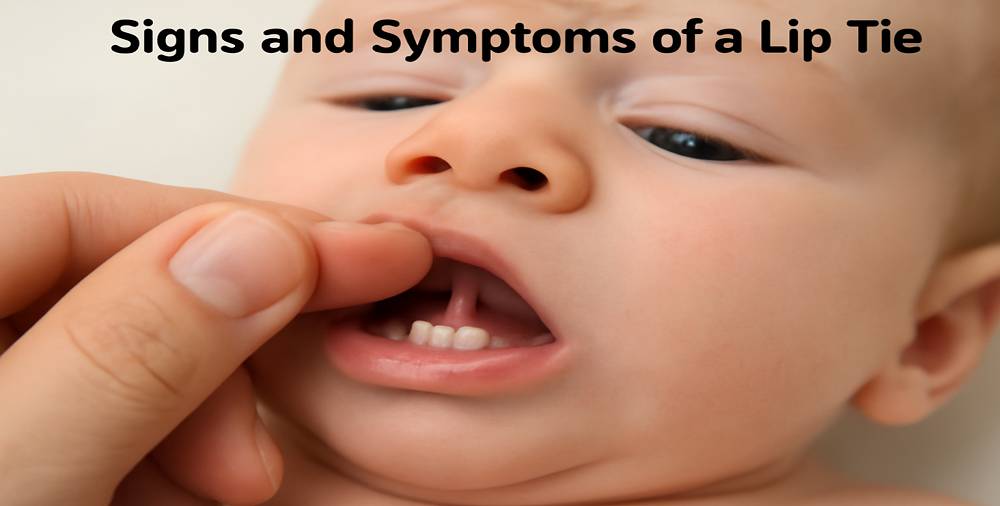A lip tie, a condition that may affect infants, children, and adults, can often go unnoticed until symptoms become severe. A lip tie refers to a condition where the frenulum, the tissue connecting the upper lip to the gum, is too tight or restrictive. This article will explore the signs and symptoms of a lip tie, how it can impact daily life, and available treatments. If you’re seeking information on how a lip tie affects breastfeeding, speech, or oral health, this guide will give you a comprehensive understanding of this condition and its impact on quality of life.
What is a Lip Tie?
A lip tie occurs when the frenulum – the tissue that connects the upper lip to the gum – is too short or thick. This tightness prevents the upper lip from moving freely, potentially causing discomfort or limitations in everyday activities. While lip ties are typically noticed in infancy, they can affect individuals of all ages.
The severity of the lip tie can vary, with some people experiencing mild discomfort while others might face significant challenges. A lip tie can also be associated with a tongue tie, another condition where the frenulum under the tongue is too tight.
Signs and Symptoms of a Lip Tie
Recognising a lip tie early can prevent long-term issues. Below are the most common signs and symptoms of a lip tie in both infants and older children or adults.
1. Breastfeeding Difficulties in Infants
One of the most common signs of a lip tie in infants is breastfeeding difficulties. The tight frenulum can prevent the baby from achieving a proper latch, leading to problems such as:
- Painful Feeding for the Mother: Mothers may experience nipple pain, cracks, or bleeding as the baby struggles to latch properly.
- Low Milk Supply: A poor latch can make it difficult for the baby to effectively suckle, leading to insufficient milk intake and potential low supply.
- Clicking Sounds During Breastfeeding: If the baby makes a clicking or popping sound while nursing, it may indicate that the lip tie is affecting their ability to form a proper seal on the breast.
2. Difficulty With Bottle Feeding
Babies with a lip tie may also have difficulty with bottle feeding. Similar to breastfeeding issues, they may struggle to latch onto the bottle nipple or may not generate enough suction to feed effectively. This can lead to frustration for both the baby and the parents.
3. Gum and Teeth Issues
As the baby grows, a lip tie can affect the development of their gums and teeth. The tension in the lip can pull on the gum line, causing gaps between the upper teeth. In some cases, the upper front teeth may develop abnormally or protrude due to this tension.
4. Speech Development Challenges in Older Children
In older children, a lip tie can potentially affect speech development. Children may have difficulty pronouncing certain sounds, particularly those that require the upper lip to move freely. This can include:
- Difficulty pronouncing “b,” “p,” or “m” sounds, as these require the upper lip to be in contact with the mouth or teeth.
- Speech delays may also occur as the child may struggle to produce clear sounds, making communication difficult.
5. Social and Oral Health Challenges in Adults
In adults, the effects of a lip tie may become more pronounced. This condition may contribute to oral health issues, such as:
- Gum Recession: The tension from the tight frenulum may pull on the gums, causing them to recede over time.
- Chronic Lip Discomfort: Adults with a lip tie may experience discomfort when eating, speaking, or smiling, due to the restriction in lip movement.
- Difficulty with Oral Hygiene: Maintaining oral hygiene can be challenging as the tight lip may interfere with proper brushing or flossing, leading to an increased risk of cavities or gum disease.
6. Difficulty Smiling or Making Facial Expressions
In some cases, individuals with a lip tie may have limited ability to smile fully or make certain facial expressions due to the restriction of their upper lip. This may impact self-esteem or social interactions, particularly in adults.
7. Nasal Speech Quality
People with lip ties may also develop a nasal speech quality. Since the lip is not fully functional in aiding the articulation of words, it may cause speech to sound more nasal. This can affect the clarity and fluidity of speech in both children and adults.
What Causes a Lip Tie?
The cause of a lip tie is typically congenital, meaning it is present at birth. It is often the result of the frenulum being too short or thick. While there is no specific reason why some babies are born with a lip tie, it can be influenced by genetics. In some families, this condition may be hereditary, passed down from one generation to the next.
How a Lip Tie is Diagnosed
A lip tie can often be diagnosed by a healthcare professional such as a paediatrician, lactation consultant, or dentist. In many cases, the diagnosis can be made by simply examining the baby’s upper lip to see if the frenulum is too tight. For older children and adults, a dental professional may be the best person to assess the severity of the condition.
In some cases, an assessment may include the following:
- Observation of Lip Movement: The healthcare provider will check for any restrictions in the movement of the upper lip and whether the frenulum is too tight or thick.
- Breastfeeding Evaluation: In infants, a lactation consultant may observe a feeding session to determine whether the baby is experiencing difficulties due to a lip tie.
Treatment Options for a Lip Tie
While some people with a lip tie experience minimal symptoms, others may require treatment. Here are the common treatment options for a lip tie:
1. Frenotomy (Lip Tie Release)
Frenotomy, also known as a frenectomy or frenuloplasty, is the most common treatment for a lip tie. This procedure involves a healthcare provider using a laser or scissors to snip the frenulum, allowing the lip to move freely. It is usually a simple and quick procedure that can be done in a healthcare professional’s office.
- For Infants: A frenotomy may be performed if breastfeeding difficulties are present. After the procedure, babies typically resume breastfeeding immediately, with improvements in latch and milk intake.
- For Older Children and Adults: A more complex procedure may be required if the lip tie has caused issues with speech, oral health, or comfort.
2. Speech Therapy
If a lip tie has caused speech delays or difficulties, speech therapy may be recommended. A speech therapist can work with children and adults to improve articulation and communication skills. This is often helpful if the lip tie is impacting pronunciation or clarity of speech.
3. Orthodontic Treatment
In cases where a lip tie has led to issues with the alignment of the teeth or gum recession, orthodontic treatment may be necessary. This could involve braces or other dental appliances to help correct any dental concerns that arise from a lip tie.
4. Post-Procedure Care
After undergoing a frenotomy, it’s essential to follow proper post-procedure care to avoid the lip tie from reattaching. This may include:
- Lip Exercises: Your healthcare provider may recommend exercises to help improve lip mobility.
- Follow-up Appointments: Regular check-ups to ensure the lip tie does not reattach.
When to See a Doctor or Dentist
If you suspect your baby or child may have a lip tie, it’s important to consult with a healthcare provider. Signs such as difficulty breastfeeding, low milk supply, or failure to thrive can indicate a lip tie. Similarly, if you or your child is experiencing speech delays or difficulty with oral health, it may be worthwhile to consult with a dentist or speech therapist who specialises in lip tie treatment.
Conclusion
A lip tie, though often overlooked, can have significant implications for an individual’s health and quality of life. Early recognition and treatment of the signs and symptoms of a lip tie can prevent long-term challenges, particularly with breastfeeding, speech, and oral health. Whether you’re dealing with an infant’s feeding difficulties or an adult’s chronic discomfort, there are treatment options available that can improve mobility, functionality, and overall well-being.
If you notice any of the signs mentioned above, it’s crucial to seek the advice of a healthcare professional to determine if a lip tie is the cause and explore the appropriate treatment options. Early intervention can make a world of difference in improving the quality of life for those affected by a lip tie.
Read More : Dental Implants Hungary Helvetic Clinics
















